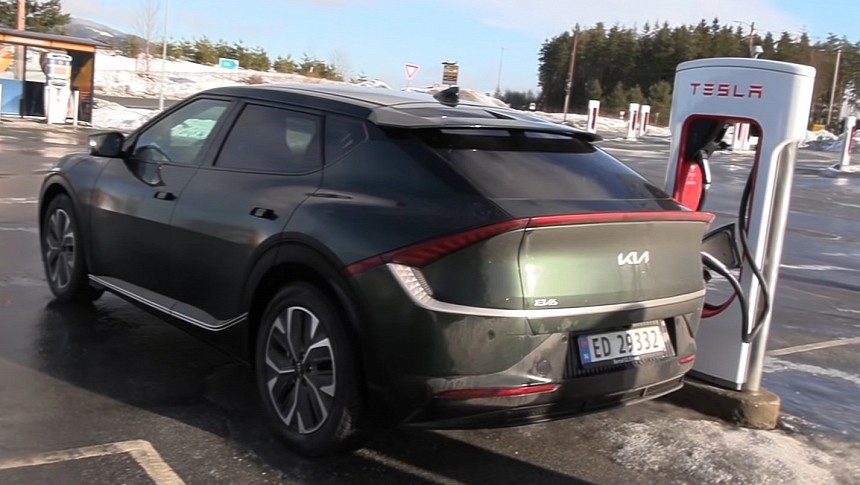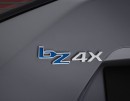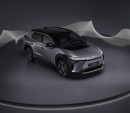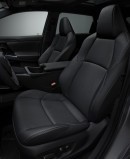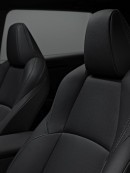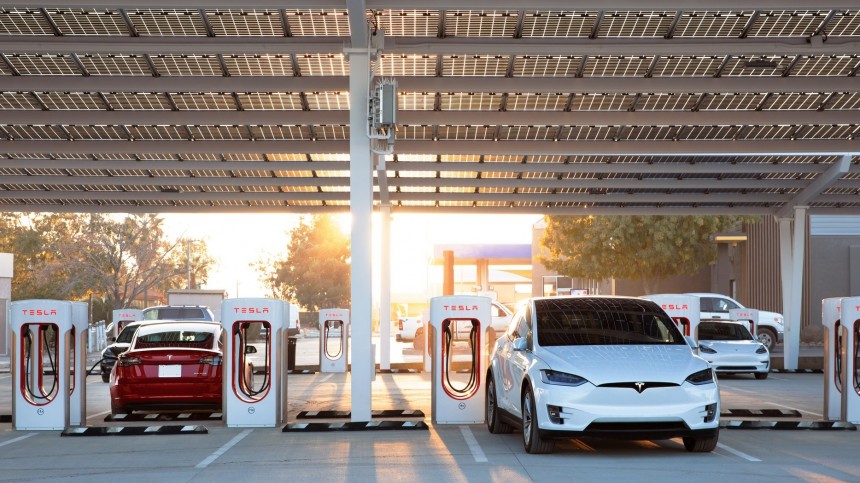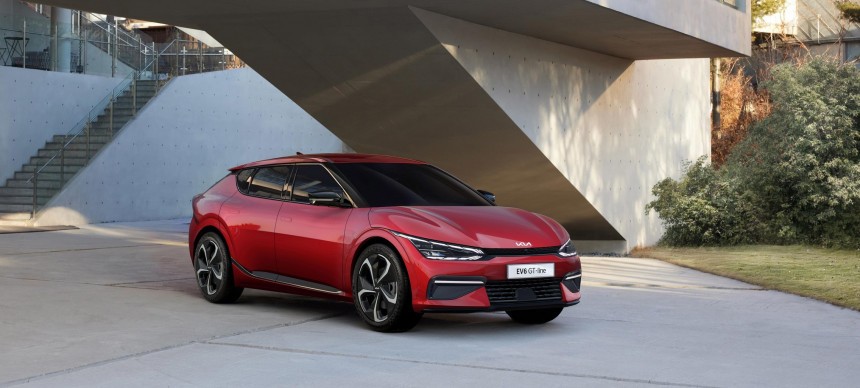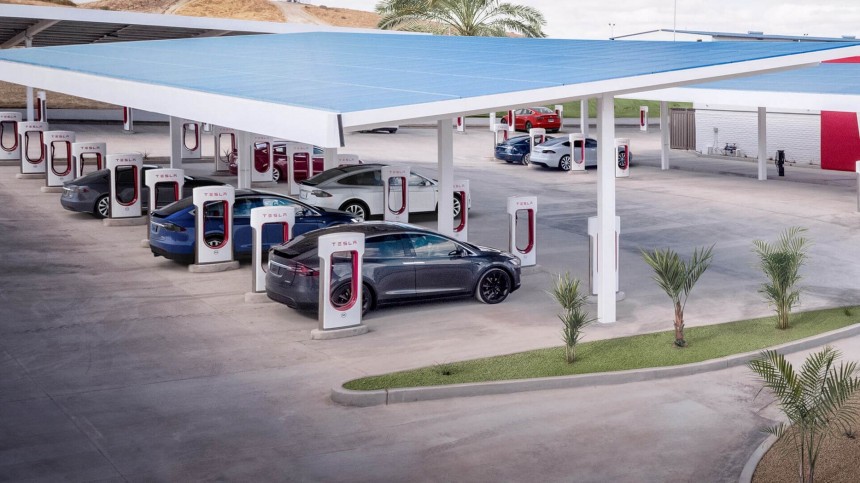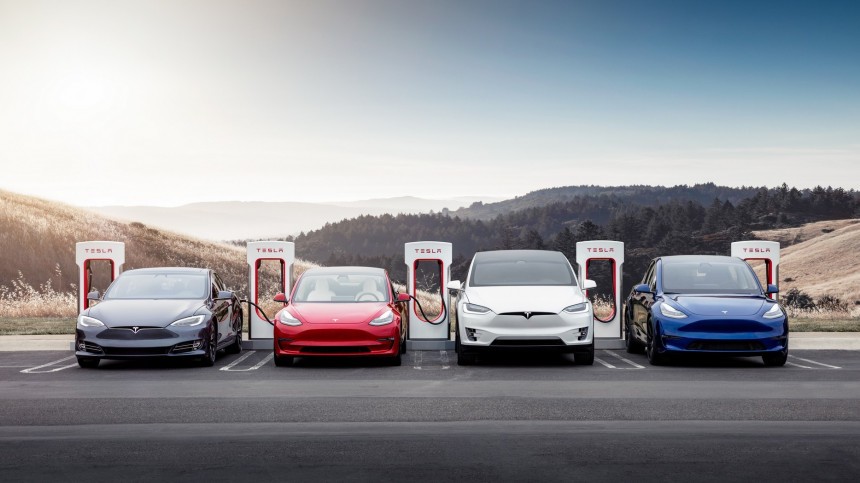General Motors announced it also made a deal with Tesla to use its Supercharging network and the North American Charging Standard (NACS). Ford did that a few weeks ago. While people bet that CCS will eventually disappear and Ford and GM should offer the Tesla charging experience with NACS charging ports, the reality will be much different.
Alex Dykes, from the YouTube channel Alex on Autos and the Auto Buyers Guide, shared his impressions on Facebook after recent tests he made on Superchargers with Magic Docks – Tesla's stalls with CCS adapters. The youtuber used a Toyota bZ4X and a Kia EV6, and, in both cases, the experience was pretty far from what a Tesla offers. Dykes also explained why they were like that.
The main point is that Superchargers were conceived for Tesla vehicles. That makes them lack operation screens because these BEVs communicate with them and present the charging information on their infotainment screens. People with other electric cars have to use the Tesla app to follow everything. That's a minor inconvenience compared to all the other issues.
Another one that will affect most BEVs from other brands is the length of the Supercharger cords. All Teslas have their charging ports under the lateral extension of the left taillight. For them to use a Supercharger, they have to reverse park in the parking spot where the equipment is located. That allows the cords to be much shorter than those used in other charging stations.
When other BEVs use a Supercharger, the cables will not reach their charging ports. Any driver who does not give up charging there will have to park their electric cars in unusual ways to get the job done, as Dykes reported. In bZ4X's case, the charging port is under the left A-pillar. If it just drives straight ahead into the parking spot, its changing port will be on the opposite side of the Supercharger. If it parks there in reverse, as Teslas must do, the Supercharger will be on the same side as the charging port, but the cord will not reach it. Either the Toyota occupies two parking spots, with the front as close to Superchargers as possible, or it uses the Supercharger from the charging spot to the left. Technically speaking, that is also a simultaneous use of two parking areas.
The Kia EV6 has its charging port under the right taillight. Reverse parking is the only option for it to use a Supercharger, and the possibilities are similar to those the bZ4X has: either the car is parked in two spots, or it uses the Supercharger from the parking spot to the left of where it is. Unfortunately, that is not the only issue owners of BEVs from other brands will face.
Superchargers were conceived to communicate with Tesla cars and vice-versa. That's what allows them to just plug and charge. Anyone expecting to do the same when connecting to a Supercharger – even if their cars come with a native NACS port – will be deeply frustrated.
Although we still do not have other vehicles with that charging standard, what Dykes endured with the bZ4X and the EV6 anticipates what GM and Ford should prevent.
With the Toyota, the youtuber tried to charge twice in one Supercharger, with little luck. He then moved to another one to try four times more. The vehicle would not connect with the Supercharger, so he just gave up. With the Kia and its 800V system, the issue was the charging speed. The EV6 can charge at more than 150 kW when connected to a 400V station, but Superchargers are not programmed to deal with BEVs that are not from Tesla.
The EV6 has a voltage boost circuit that allows it to extract 800V charging from a 400V stall. Superchargers interpret that as a charging fault and interrupt the process. Although Kia and Hyundai are working with Tesla to solve that, the temporary solution was to limit charging speeds to 50 kW, which is pretty slow for the EV6. The Hyundai IONIQ 5 and IONIQ 6, which share the same E-GMP platform as the Kia, will also benefit from the solution these automakers may develop.
Multiply these situations by all the BEVs in the market from different brands and charging systems, and you'll see the Magic Dock cannot perform miracles. It may be the case that NACS will deliver a more pleasant charging experience to GM and Ford customers in Supercharging stations, but only if these two automakers go beyond adopting just that charging standard.
As Tesla will not put much longer charging cords in its stalls, Ford and GM will have to place the charging ports in their new BEVs in the left rear quarter of their cars. They will also have to work with Tesla for their vehicles to communicate with Superchargers in a better way than all other BEVs currently do with the Magic Docks. You may also follow what Tesla advocates defended in Dykes' post – just buy a Tesla – but that is just ignoring the problem.
The truth is that Superchargers provide the same lousy charging experience other charging networks offer to BEVs that are not from Tesla. If the secret to a smooth charging session is having a closed ecosystem, then we should be discussing more than just the format of plugs: all BEVs should have the same charging protocols. In other words, the charging standard should comprise more than just how you connect your car to the stalls. The interaction between BEVS and chargers is the crucial aspect most people are ignoring. Let's see how (and if) GM and Ford will make that better with NACS.
The main point is that Superchargers were conceived for Tesla vehicles. That makes them lack operation screens because these BEVs communicate with them and present the charging information on their infotainment screens. People with other electric cars have to use the Tesla app to follow everything. That's a minor inconvenience compared to all the other issues.
When other BEVs use a Supercharger, the cables will not reach their charging ports. Any driver who does not give up charging there will have to park their electric cars in unusual ways to get the job done, as Dykes reported. In bZ4X's case, the charging port is under the left A-pillar. If it just drives straight ahead into the parking spot, its changing port will be on the opposite side of the Supercharger. If it parks there in reverse, as Teslas must do, the Supercharger will be on the same side as the charging port, but the cord will not reach it. Either the Toyota occupies two parking spots, with the front as close to Superchargers as possible, or it uses the Supercharger from the charging spot to the left. Technically speaking, that is also a simultaneous use of two parking areas.
Superchargers were conceived to communicate with Tesla cars and vice-versa. That's what allows them to just plug and charge. Anyone expecting to do the same when connecting to a Supercharger – even if their cars come with a native NACS port – will be deeply frustrated.
Although we still do not have other vehicles with that charging standard, what Dykes endured with the bZ4X and the EV6 anticipates what GM and Ford should prevent.
The EV6 has a voltage boost circuit that allows it to extract 800V charging from a 400V stall. Superchargers interpret that as a charging fault and interrupt the process. Although Kia and Hyundai are working with Tesla to solve that, the temporary solution was to limit charging speeds to 50 kW, which is pretty slow for the EV6. The Hyundai IONIQ 5 and IONIQ 6, which share the same E-GMP platform as the Kia, will also benefit from the solution these automakers may develop.
As Tesla will not put much longer charging cords in its stalls, Ford and GM will have to place the charging ports in their new BEVs in the left rear quarter of their cars. They will also have to work with Tesla for their vehicles to communicate with Superchargers in a better way than all other BEVs currently do with the Magic Docks. You may also follow what Tesla advocates defended in Dykes' post – just buy a Tesla – but that is just ignoring the problem.
